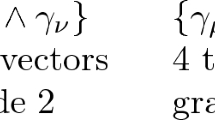Summary
The transformations of ordinary quantum mechanics between reference frames in arbitrary relative motion are derived by using the theorem on the uniqueness of the irreducible representations of finitely many CCR. In the course of the derivation, it is found that the Hamiltonian is the affine connection coefficient for a gauge theory in which the base manifold is time and the fibre is the group of all unitary operators on the Hilbert space of states. It follows that Schrödinger equation is covariant with respect to this gauge group. This includes the transformations between reference frames, and the gauge transformations of the scalar and vector potentials, so that Schrödinger equation is covariant with respect to them.
Similar content being viewed by others
References
See, for example,I. I. Rabi, N. F. Ramsey andJ. Schwinger:Rev. Mod. Phys.,26, 167 (1954).
The transformation law for the affine connection coefficients for a non-Abelian gauge theory appears for the first time in a paper by E. Schrödinger on Dirac equation in general relativity in:Sitzungsber. Preuss. Akad. Wiss. Phys.-Math. Kl., 105 (1932). For the forerunners of this paper and later developments, see,e.g.,G. Parravicini: Tesi dell'Università di Pavia (1966), unpublished, andM. Brignoli andA. Loinger:Nuovo Cimento A,80 477 (1984).
See for example, with an easy adaptation,C. R. Putnam:Commutation Properties of Hilbert Space Operators and Related Topics (Springer-Verlag, Berlin, etc., 1967), Theorem 4.14.1.
Classical quantities thatneed being distinguished from the corresponding quantum quantities are denoted by a tilde.
For the classical Hamiltonian structure with velocity-dependent potentials seeA. Zecca:Some elementary considerations on the structure of the force deriving from a generalized potential energy, Internal Report, Dipartimento di Fisica dell'Università di Milano (1980), unpublished.
See appendix A for symbols.
See appendix A forR(t), etc.
See,J.-M. Lévy-Leblond:Riv. Nuovo Cimento,4, 99 (1974).
Author information
Authors and Affiliations
Rights and permissions
About this article
Cite this article
Parravicini, G. Schrödinger Hamiltonians as affine connections. Nuov Cim A 103, 1403–1416 (1990). https://doi.org/10.1007/BF02820569
Received:
Published:
Issue Date:
DOI: https://doi.org/10.1007/BF02820569



